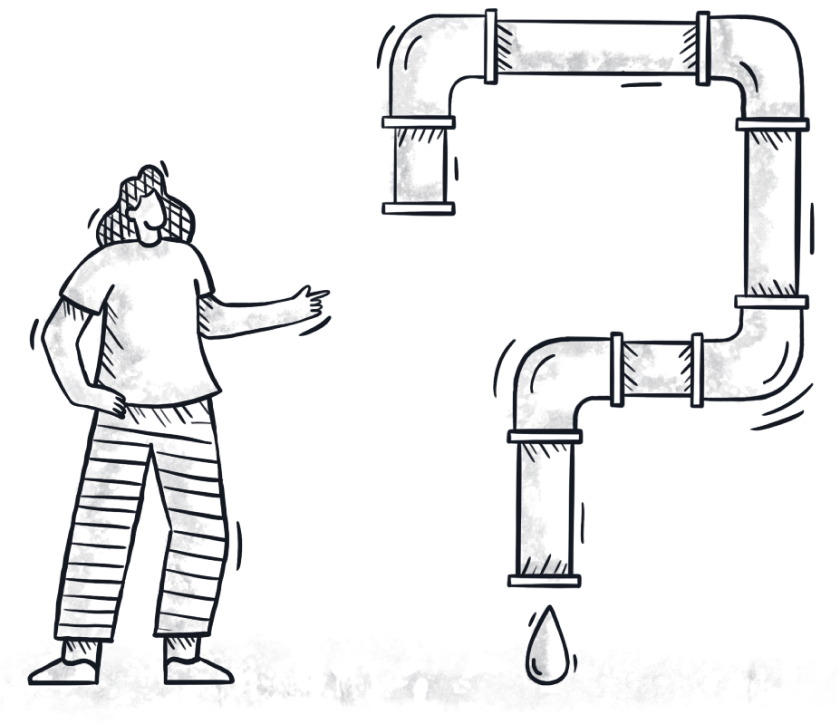Technology Identification and Selection
An appropriate sanitation system is a compatible combination of appropriate technologies to provide a socially and environmentally acceptable service at an affordable cost. Appropriateness needs to be assessed through technical, geophysical, socio-cultural, financial and institutional factors as well as aspects related to skills and local capacity. Because of the many possible technology options and selection criteria, rapid decision-making difficult. A clear framework can help.
During the acute phase the priority is the installation of latrines (user interface and on-site storage) that are safe for the users and prevent public health risks from faecal waste (see also How to Design and Implement Appropriate and Sustainable Toilets?). During this phase consider socio-cultural preferences, geophysical factors such as the risk of flooding, the availability of funds and materials and how fast a solution is required. Both SaniTweaks (Oxfam 2022) and Excreta Disposal in Emergencies (Harvey 2007) provide simple checklists to answer these questions. The Initial Assessment must ensure that the information is collected along with the specific needs of the targeted communities. For instance, for vulnerable groups, simple add-ons like lighting or handrails at the stairs can make a big difference. How to Design and Implement Appropriate and Sustainable Toilets/Latrines also provides additional guidance.
The focus of the stabilisation phase is to move from communal to shared latrines and then to household latrines to provide a solution for the management of excreta and faecal sludge. Aspects to consider in this phase include whether the infrastructure could be upgraded and the availability of service providers, trucks and equipment and whether the environment has access and space for on-site treatment or removal. See also the following pages for more details: How to Select Appropriate Emptying and Transport Technologies? and How to Select Appropriate Treatment Technologies?, It is advisable to consider design options for the superstructure and the slab (user interface) and the pit (on-site storage) separately and to use locally available materials for each component where possible. Decisions about whether to integrate bathing units are taken in this phase and about how to deal with greywater in general. If desludging is needed, treatment focuses on safe containment and pathogen removal. In places where a system already exists but is damaged, the focus is on providing temporary emergency solutions while trying to rehabilitate the existing one. Often when the stabilisation phase is reached, there is hardly any budget remaining. Hence the best that can be achieved is simple pit latrines with household participation. However, using the table above to plan for sanitation infrastructure along the entire sanitation value chain from the beginning can support additional fund-raising or handover to other providers.
In the recovery phase, the objective the aim is to establish a longer-term sanitation service with appropriate technologies along the entire service chain (including treatment and safe disposal or reuse) that can be operated and maintained either directly by the community or by public institutions or private service providers (see also Exit Strategy). In this phase, the focus is on the selection of appropriate Emptying and Transport, Treatmentand Safe Disposal or Use Technologies considering the Quantities of Faecal Sludge or compost/ pit humus. The technology for treatment will depend on the latrines and collection services already in place. Establish Standards and look for synergies with the existing infrastructure and avoid creating inequalities with the host population. On-site facilities may need to be upgraded, safe treatment and disposal facilities put in place and Management Plans and Financial Plans developed according to the locally available budget, skills and capacities. Greywater and Solid Waste Management should also be considered to avoid the dilution of faecal matter with greywater and to ensure that solid waste does not end up in pits or clog drains. In some circumstances, reuse might be an option if demand exists.
Factors to consider for choosing a given type of system
For an overview on system template, see also What Different Sanitation Systems and Technologies Exist?.
- WASH infrastructure and services already in place in the area (to use synergies and detect user preferences in terms of accessibility).
- Institutional and regulatory environment (e.g. groundwater protection or construction laws).
- Preferences of the user groups to be served (socio-cultural acceptance, e.g. religious constraints such as the orientation of the user interface).
- Demographics: number of users per user interface, special requirements for children, women, elderly and disabled people.
- Human and technical capacities available for collection of products, i.e. transport available on the area and potential partners from the host communities or other humanitarian aid organisation.
- Synergies with infrastructure and services in host communities.
- Possibilities for resource recovery (urine as fertiliser, compost, effluent for irrigation etc.).
- Safety conditions.
- Land use in the area (ex. Agricultural practices).
Based on these factors, it can already be identified, which type of system templates are potentially feasible, this will reduce the technology choice for the further steps of sanitation system design.
Factors to Consider for Technology Selection
For an overview of technology options go to the Compendium and for a full list of technology selection criteria go to SaniChoice/Selection tools.
Socio-cultural:
-
- Religious beliefs
- Cleansing methods (ashers or wipers)
- Vulnerable groups (women, elderly, children, disabilities)
- Availability of finance
- Readiness for reuse
Geophysical:
-
- Ease of access for supply chain and staff (vehicular access to assess the feasibility of sewered or motorised collection)
- Soil-conditions for construction,
- Groundwater table
- Topography and slope
- Location and size of water sources, incl. availability of water for flushing, risk for groundwater contamination
- Space availability on-site (for on-site storage, treatment, and disposal) and off-site (for centralised treatment and disposal)
- Climatic conditions – including rainfall patterns and risk of flooding, minimal and maximum temperature
Technical:
-
- Availability of water for flushing or transportation
- Electricity supply
- Availability of materials and workforces readily available for construction and regular repairs (e.g. concrete, pumps, pipes, etc)
- Availability of fuel if motorized transport is planned
- Technical maturity (technology readiness level TLR)
Managerial:
-
- Design, construction and operation and maintenance skills available/required
Specific to emergency:
-
- Degree of urgency to inform the speed of implementation required
- Scalability (expansion)
- Lifetime and possibilities for upgrading
The factors above need to be evaluated in the baseline assessment, see also: 2.1 Data Collection and Sources, 2.2 Context Analysis, 2.3 Needs Assessment and Analysis

-
Bibliography
Excreta Disposal in Emergencies: A Field Manual
Preparing to be Unprepared - Decision Making and the Use of Guidance on Sanitation Systems and Faecal Sludge Management in the First Phase of Rapid-Onset Emergencies
Generation and Evaluation of Sanitation Options for Urban Planning: Systematic Consideration of Technology Innovations and Sustainability Criteria
Towards more Sustainable Sanitation Solutions - SuSanA Vision Document
Decision Tree for Excreta Disposal in Refugee Camps
Key Resources and Tools
Compendium of Sanitation Technologies in Emergencies
The Compendium of Sanitation Technologies in Emergencies is a comprehensive and structured capacity development and…
SaniChoice
A capacity development and decision support tool that makes sanitation technology and system selection more…
Excreta Disposal in Emergencies: A Field Manual
It is generally accepted that excreta disposal is given less priority in emergencies than other…
Sanitation in Humanitarian Settings
In an emergency the collection, treatment and disposal/reuse of human waste is critical to the…
Emergency Sanitation: Assessment and Programme Design
This book has been written to help all those involved in planning and implementing emergency…
Sani Tweaks Best Practices in Sanitation
Studies have shown that agencies are failing to properly consult or collect and act on…
How to Select Appropriate Technical Solutions for Sanitation
The purpose of this guide is to assist local contracting authorities and their partners in…
Sanitation in Humanitarian Settings
In an emergency the collection, treatment and disposal/reuse of human waste is critical to the…
Sanitation Systems & Technologies MOOC
The MOOC series “Sanitation, Water and Solid Waste for Development” is an open-access, full-fledged eLearning…
Faecal Sludge Management (FSM) - Systems Approach for Implementation and Operation
Over a billion people in urban and peri-urban areas of Africa, Asia, and Latin America…
Characterization of Faecal Sludge
Found what you were looking for?
Still have questions?
You could not find the information you were looking for? Please contact our helpdesk team of experts for direct and individual support.

